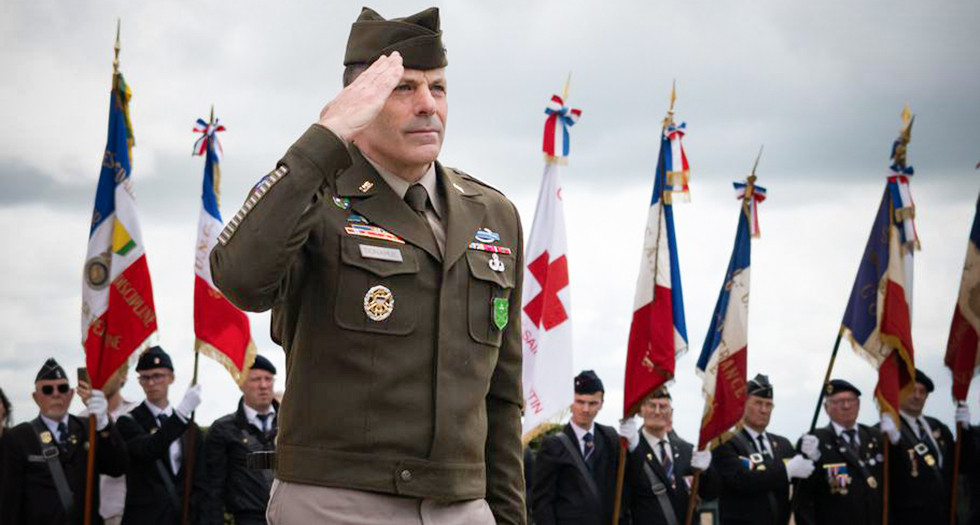
Memorial Day In Europe, Trump calls Putin ‘crazy’ after massive drone attack on Ukraine, and just how much the U.S. spent recruiting and retaining servicemembers in the past three years.
1. The commander in charge of Army operations in Europe led Memorial Day tributes Sunday at the Somme American Cemetery, where some of the first American troops to die in combat on European soil are buried. Gen. Christopher T. Donahue, commanding general of U.S. Army Europe and Africa, said that although the nearly 1,850 soldiers interred at the site died more than a century ago, their service must never be forgotten. “Honoring their sacrifices reminds us that freedom isn’t free and that the American soldier will go and fight wherever, and whenever, their nation calls,” Donahue said. The event was one of about two dozen held in Europe over Memorial Day weekend at cemeteries run by the American Battle Monuments Commission. More than 100,000 Americans who fought in both world wars are buried at ABMC sites in Europe beneath white crosses and Stars of David — enduring reminders of the sacrifice that helped secure the Continent’s freedom.
2. Russia overnight launched the biggest drone attack on Ukraine in the more than three-year war, a Ukrainian official said Monday. U.S. President Donald Trump said Russian leader Vladimir Putin has gone “crazy” by stepping up the bombing of Ukraine while the U.S. tries to broker peace. The Russian bombardment on Sunday night included 355 drones, Yuriy Ihnat, head of the Ukrainian air force’s communications department, told The Associated Press. Russia also fired nine cruise missiles during the attack, Ukrainian authorities said. Officials reported some civilians were injured. No deaths were immediately reported. On Saturday night, the Ukrainian capital Kyiv and other regions came under a massive Russian combined drone-and-missile attack that killed at least 12 people and injured dozens. Ukrainian officials described that bombardment as Russia’s largest aerial assault during the conflict, using 69 missiles of various types and 298 drones.
3. The U.S. military spent more than $6 billion over the past three years to recruit and retain servicemembers, in what has been a growing campaign to counter enlistment shortfalls. The financial incentives to reenlist in the Army, Navy, Air Force and Marines increased dramatically from 2022 through last year, with the Navy vastly outspending the others, according to funding totals provided by the services. The overall amount of recruiting bonuses also rose steadily, fueled by significant jumps in spending by the Army and Marine Corps. The military services have routinely poured money into recruiting and retention bonuses over the years. But the totals spiked as Pentagon leaders tried to reverse falling enlistment numbers, particularly as COVID-19 restrictions locked down public events, fairs and school visits that recruiters relied on to meet with young people.
4. President Donald Trump on Sunday indicated there was progress with Iran on its nuclear program and hinted that an announcement could come in the “next two days.” He was notably more upbeat than the Omani mediator of the talks between the United States and Iran, who said Friday that the two nations made “some but not conclusive” progress in the fifth round of negotiations in Rome. “We’ve had some very, very good talks with Iran,” Trump told reporters in northern New Jersey after leaving his golf club, where he spent most of the weekend. “And I don’t know if I’ll be telling you anything good or bad over the next two days, but I have a feeling I might be telling you something good.” He emphasized that “we’ve had some real progress, serious progress” in talks that took place on Saturday and Sunday. “Let’s see what happens, but I think we could have some good news on the Iran front,” Trump said.
5. As the World War II bomber Heaven Can Wait was hit by enemy fire off the Pacific island of New Guinea on March 11, 1944, the co-pilot managed a final salute to flyers in an adjacent plane before crashing into the water. All 11 men aboard were killed. Their remains, deep below the vast sea, were designated as non-recoverable. Yet four crew members’ remains are beginning to return to their hometowns after a remarkable investigation by family members and a recovery mission involving elite Navy divers who descended 200 feet (61 meters) in a pressurized bell to reach the sea floor. Staff Sgt. Eugene Darrigan, the radio operator was buried military honors and community support on Saturday in his hometown of Wappingers Falls, New York, more than eight decades after leaving behind his wife and baby son. The bombardier, 2nd Lt. Thomas Kelly, was to be buried Monday in Livermore, California, where he grew up in a ranching family. The remains of the pilot, 1st Lt. Herbert Tennyson, and navigator, 2nd Lt. Donald Sheppick, will be interred in the coming months.
- News

